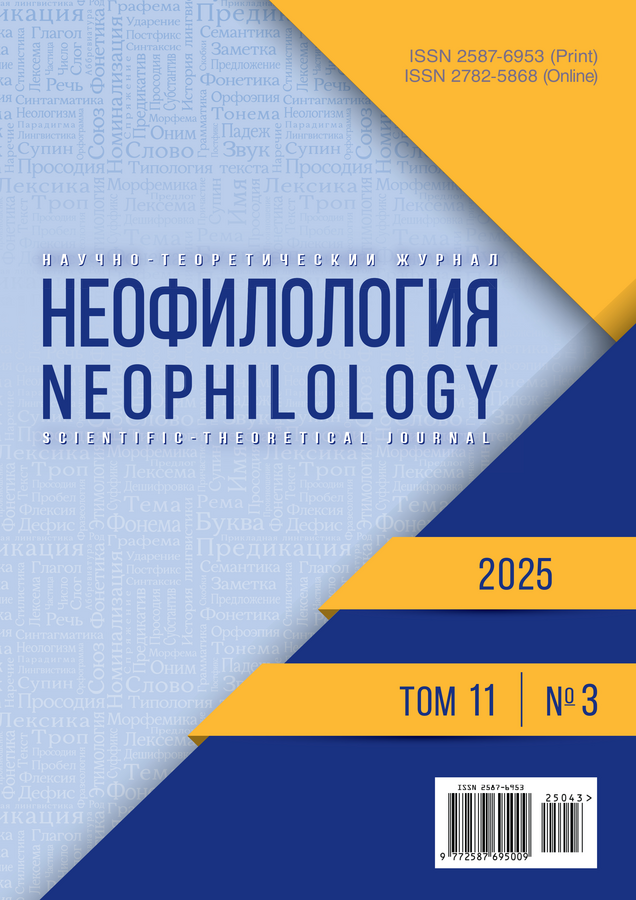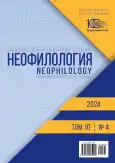Романтические мотивы в китайском искусстве: истоки и особенности
- Авторы: Лю Х.1
-
Учреждения:
- ФГБОУ ВО «Московский педагогический государственный университет»
- Выпуск: Том 10, № 4 (2024)
- Страницы: 1027-1034
- Раздел: ТЕОРИЯ И ИСТОРИЯ КУЛЬТУРЫ
- URL: https://journal-vniispk.ru/2587-6953/article/view/295641
- DOI: https://doi.org/10.20310/2587-6953-2024-10-4-1027-1034
- ID: 295641
Цитировать
Полный текст
Аннотация
ВВЕДЕНИЕ. В традиционной китайской культуре романтические мотивы всегда были одной из центральных тем художественного творчества. Рассмотрение культурно-исторических особенностей формирования романтических установок в китайском искусстве представляется актуальным для более глубоко понимания феномена «романтизма» в мировой культуре на уровне стилевых черт и художественных приёмов вне зависимости от национальной принадлежности. Цель исследования – показать, что романтическая тематика в китайском искусстве имеет глубокие культурно-исторические корни. Новизна исследования заключается в попытке показать, что уникальные особенности китайского романтизма оказали влияние как на китайское, так и на современное мировое искусство.МАТЕРИАЛЫ И МЕТОДЫ. Материал исследования – исторические документы и произведения традиционного китайского искусства и культуры. Использован метод историко-культурного анализа.РЕЗУЛЬТАТЫ ИССЛЕДОВАНИЯ. Выявлено, что романтические мотивы в китайском искусстве находят отражение не только в воспевании природной красоты, но и в стремлении к внутреннему покою и духовной свободе.ЗАКЛЮЧЕНИЕ. Более глубокое понимание романтического мотива в китайском искусстве имеет большое значение для лучшего понимания содержания и структуры базовых ценностей китайской культуры.
Об авторах
Хаосюань Лю
ФГБОУ ВО «Московский педагогический государственный университет»
Автор, ответственный за переписку.
Email: kh_lu22@student.mpgu.edu
ORCID iD: 0009-0008-9432-6402
аспирант, кафедра культурологии
119991, Российская Федерация, г. Москва, ул. Малая Пироговская, 1, стр. 1Список литературы
- Гареева Э.А., Лукьянов А.В. Романтический «дух» как идея разума: контуры и новые контексты идентификации в свете принципа дополнительности // Kant. 2019. № 1. С. 170-175. https://elibrary.ru/zbuevf
- Ванслов В.В. Эстетика романтизма. М.: Искусство, 1966. 402 с.
- Жебраускас А.Л. Понятие культурных констант и поиски ориентиров постсовременности // Известия РГПУ им. А.И. Герцена. 2006. Т. 3. № 20. С. 18-21. https://elibrary.ru/gpjcfr
- Махортова О.В., Мордовина Л.В. Особенности символики и знаковости Китая // Аналитика культурологии. 2011. № 1 (19). С. 137-139. https://elibrary.ru/qzcopr
- Люй Чао, Кемерова Т.А. Эстетическая культура Китая периода Китайской Республики и её влияние на развитие живописи // Известия УрФУ. Серия 1. Проблемы образования, науки и культуры. 2022. Т. 28. № 2. C. 137-148. https://doi.org/10.15826/izv1.2022.28.2.033, https://elibrary.ru/qbxlba
- Дэн Цзюньхай. Романтизм в изучении классической китайской эстетики // Журнал «Эстетическое образование». 2015. № 6. С. 42-49. https://chn.oversea.cnki.net/kns/manage/export.html?displaymode=NEW&filename=CJFDLAST2015!MYXK201501009!1!4
- Чжан Жуньмэй. История китайской эстетики Ли Цзэхоу // Вестник Московского университета. 2019. № 1. С. 109-118. https://elibrary.ru/vvvfpq
- Сюй Фугуань. Дух китайского искусства. Шанхай: Изд-во Восточно-китайского педагогического университета, 2001. 355 с. https://www.sklib.cn/booklib/databasedetail?SiteID=122&ID=9614786&fromSubID=
- Тан Сюй. Анализ особенностей художественного исполнения произведения Ли Бая «Дорога в Шу» // Построение языка. 2013. № 17. C. 9-10. https://wenku.baidu.com/view/d3451913a8956bec0875e30b?fr=xueshu&_wkts_=1730909917569
- Ма Шухао. Китайская литература в произведениях современного композитора Го Вэньцзина // Вестник музыкальной науки. 2022. Т. 10. № 2. С. 164-165. https://doi.org/10.24412/2308-1031-2022-2-162174, https://elibrary.ru/elnccj
- Чжоу Гуаньюй. Экологические последствия мысли конфуцианства о «единстве неба и человека» // Народный форум. 2017. № 580. C. 140-141. http://www.rmlt.com.cn/2018/0102/507575.shtml
- Цзинь Жун. Краткая дискуссия о гуманистическом духе традиционной китайской культуры и её современном значении // Журнал Юньнаньского социалистического института. 2015. № 67. C. 107-110. https://chn.oversea.cnki.net/KCMS/detail/detail.aspx?dbcode=CJFD&dbname=CJFDLAST2016&filename=YNSH201503023&uniplatform=OVERSEA&v=IbxsGmgZlOVuCD5h5ihBvwrwKDx2FrXVUWLpowrs3IWC376TBZUXhj3OdN6LCVS7
- Ма Хуэйди. Взгляд на природу в китайской культурной традиции // Журнал Лоянского педагогического колледжа. 2019. № 38. C. 1-7. https://chn.oversea.cnki.net/KCMS/detail/detail.aspx?dbcode=CJFD&dbname=CJFDLAST2019&filename=LSZB201907002&uniplatform=OVERSEA&v=aHKH8HSoMk9d_whJnpTQXMxsbezREPCOeIkEUy39Zo0Tn7CG0bBhoFEKXV2KblJv
- У Юйси. Оценка древнего стихотворения «Войдёт в вино» // Молодые литераторы. 2022. № 35. С. 121-123. https://chn.oversea.cnki.net/KCMS/detail/detail.aspx?dbcode=CJFD&dbname=CJFDLASN2023&filename=QNWJ202235075&uniplatform=OVERSEA&v=llfJKsf_OqLYZOtRaiC6x3zbJd5JwBIUWufmDFKsM_3OdeHwkItCiYLmWvGDPiG
- Горький М. История русской литературы. Шанхай: Изд-во переводов, 1979. 523 с.
- Овчаренко О.А. М. Горький как теоретик литературы // Studia Litterarum. 2018. Т. 3. № 1. С. 234-251. https://doi.org/10.22455/2500-4247-2018-3-1-234-251, https://elibrary.ru/ysvkye
Дополнительные файлы











